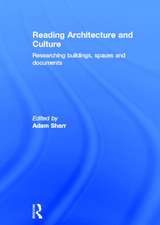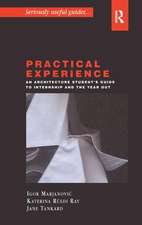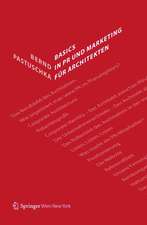Transcultural Architecture: The Limits and Opportunities of Critical Regionalism
Autor Thorsten Botz-Bornsteinen Limba Engleză Paperback – 12 oct 2017
| Toate formatele și edițiile | Preț | Express |
|---|---|---|
| Paperback (1) | 312.43 lei 6-8 săpt. | |
| Taylor & Francis – 12 oct 2017 | 312.43 lei 6-8 săpt. | |
| Hardback (1) | 767.50 lei 6-8 săpt. | |
| Taylor & Francis – 28 aug 2015 | 767.50 lei 6-8 săpt. |
Preț: 312.43 lei
Preț vechi: 364.17 lei
-14% Nou
Puncte Express: 469
Preț estimativ în valută:
59.78€ • 62.64$ • 49.42£
59.78€ • 62.64$ • 49.42£
Carte tipărită la comandă
Livrare economică 12-26 aprilie
Preluare comenzi: 021 569.72.76
Specificații
ISBN-13: 9781138573468
ISBN-10: 1138573469
Pagini: 224
Dimensiuni: 174 x 246 x 20 mm
Greutate: 0.45 kg
Ediția:1
Editura: Taylor & Francis
Colecția Routledge
Locul publicării:Oxford, United Kingdom
ISBN-10: 1138573469
Pagini: 224
Dimensiuni: 174 x 246 x 20 mm
Greutate: 0.45 kg
Ediția:1
Editura: Taylor & Francis
Colecția Routledge
Locul publicării:Oxford, United Kingdom
Notă biografică
Thorsten Botz-Bornstein was born in Germany and studied philosophy in Paris and Oxford. As a postdoctoral researcher based in Finland he undertook extenÂsive research on Russian formalism and semiotics in Russia and the Baltic countries. He has also been researching in Japan, in particular on the Kyoto School and on the philosophy of Nishida Kitarô. At present he is Associate Professor of Philosophy at the Gulf University for Science and Technology in Kuwait. His publications are: Place and Dream: Japan and the Virtual (Rodopi, 2004); Films and Dreams: Tarkovsky, Sokurov, Bergman, Kubrik, Wong Kar-wai (Lexington Books 2007); La Chine contre l’Amérique. Culture sans civilisation contre civilisation sans culture? (Paris: L’Harmattan 2012) ; Vasily Sesemann: Experience, Formalism and the Question of Being (Rodopi 2006); Aesthetics and Politics of Space in Russia and Japan (Lexington Books 2009); The Cool-Kawaii: Afro-Japanese Aesthetics and New World Modernity (Lexington 2010); The Veil in Kuwait: Gender, Fashion, Identity (with Noreen Abdullah-Khan, Palgrave 2014); Editor of: The Philosophy of Viagra: Bioethical Responses to the Viagrification of the Modern World (Rodopi, 2011); Inception and Philosophy: Ideas to Die For (Chicago: Open Court, 2011). Re-ethnicizing the Minds? Tendencies of Cultural Revival in Contemporary Philosophy (Amsterdam: Rodopi, 2006). The Crisis of the Human Sciences: False Objectivity and the Decline of Creativity (2010) Nature Culture, Memes (2008).
Cuprins
Introduction; Chapter 1 Reima Pietilä’s Kuwait Buildings Revisited; Chapter 2 Empathy, Abstraction, Style, Non-Style; Chapter 3 “Magic Internationalism” or the Paradox of Globalization; Chapter 4 Wang Shu and the Possibilities of Critical Regionalism in China; Chapter 5 When the Monumental Becomes Decorative; Chapter 6 Play, Dream, and the Search for the “Real” Form of Dwelling; Chapter 7 Wittgenstein’s Stonborough House and the Architecture of Tadao Ando; Chapter 8 Cardboard Houses with Wings; Chapter 9 H-Sang Seung; Chapter 10 The Secularization of the Architectural Heritage through Wahhabism in Saudi Arabia; Chapter 101 Conclusion;
Descriere
This book shifts the focus from Critical Regionalism towards a broader concept of 'Transcultural Architecture' and defines Critical Regionalism as a subgroup of the latter. One of the benefits that this change of perspective brings about is that a large part of the political agenda of Critical Regionalism, which consists of resisting attitudes forged by typically Western experiences, is 'softened' and negotiated according to premises provided by local circumstances. At the book’s centre is an analysis of Reima and Raili Pietilä’s Sief Palace Area project in Kuwait. Further cases of modern architecture in China, Korea, and Saudi Arabia show that the critique, which holds that Critical Regionalism is a typical 'western' exercise, is not sound in all circumstances. Furthermore, the book proposes that a certain 'architectural rationality' can be contained in architecture itself - not imposed by outside parameters like aesthetics, comfort or even tradition.



















